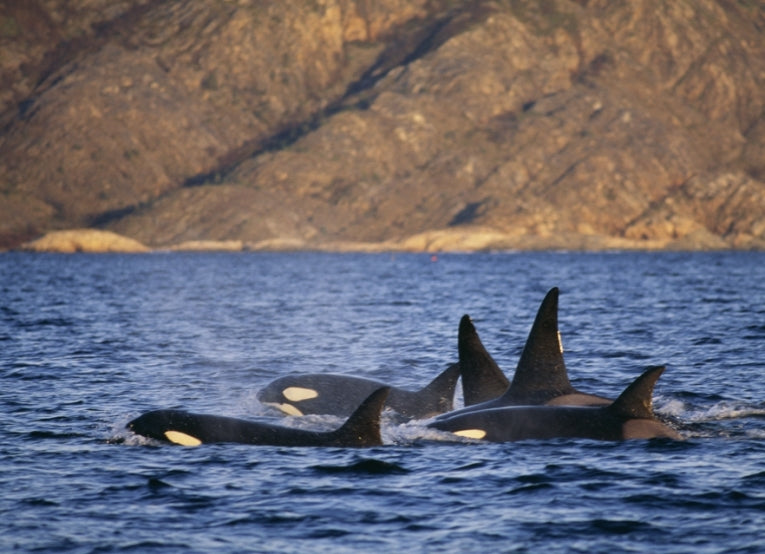The niche of a species is its lifestyle. Minute ecological effects create the niche meaning many populations of a species differ and could be on the way to speciation themselves. This applies as long as Darwin's pre-requisite of reproductive separation is maintained. The killer whale, Orcinus orca, seems to be sufficiently isolated in some of its populations for totally different "cultures" to have evolved. Their niches differ most obviously in their feeding. There has been little progress in the North Sea orca who specialise in predating harbour seals, mackerel and herring, but the classic orca situation in the NE Pacific gives us much more to get our teeth into.
These top Pacific predators eat a broad range of animals, but many animals specialise in a much narrower range. Sympatric (living in the same place) populations in the NE Pacific form two very distinct "ecotypes." These 2 ecotypes possess a different niche because one eats fish and the other eats mammals. Being reproductively isolated means that speciation has progressed, with a probable period of separation followed by the current sympatric situation where 2 populations may been forced together because prey became available.
So the question this paper tried to answer was, "Does the speciation of orcas start to take place while they are living in the same place? (sympatric speciation.) The achievement an answer would be magnificent, if niche variation between the 2 NE Atlantic populations could be observed. This variation could be the raw material for their adaptive radiation.
Then this would lead to the early stages of ecotype formation or speciation. Andrew D. Foote of the University of Copenhagen and colleagues from varied sources such as Scotland, the Netherlands, Greenland and Western Australia has written their paper, "Tracking niche variation over millennial timescales in sympatric killer whale lineages," in the Proceedings of the Royal Society B: Biological Sciences.

Three orca specimens from Northern Jutland, Denmark with the same mDNA control region haplotype illustrate the variation in isotopic niche among samples:
(i) subfossil teeth radiocarbon dated to 6800 14C years BP;
(ii) a specimen which had fish bones in its stomach;
(iii) a specimen which had the remains of several harbour seals and harbour porpoise in its stomach. The worn teeth found in all three specimens suggest some overlap in the diet, the isotopic differences suggest differences between these individuals in the relative proportions of prey species consumed.
23 sub fossil bones and teeth were dredged from the Southern Bight and brought from Iron Age midden-sites in Southern Scandinavia. Basically they were Holocene and therefore over 1000 years old. All animals were thought to be over weaning age at 4 years old or more. Comparison with specimens dating from 1865 to 1995, currently in museums consisted of mtDNA sequencing and determination of stable isotope ratios. The isotopes obtained gave an excellent measure of prey resources.
Results showed very similar values for prey range, but there was a greater spread in recent animals. For 200 to 450 generations (with a generation time of 15years), there seemed to be a concentration of herring-eaters near Norway, and more mammal predation near Iceland. Recent divergence of niche seems possible, but mating systems could have a lot to do with the situation found by the researchers. A Greenland group with seals in their stomach could be assumed to have bred with the fish-eating group of Norway and Iceland. The seal- eating group was therefore indistinguishable from the fish-eating groups.
Generalist feeding normally has better fitness levels than specialist feeders. To be efficient, the matrilineal learning of an effective hunting strategy is required. Silent travel and use of a small group with which to attack animals with acute hearing are the epitome of a mammal- hunting orca; the fish-hunters predate small clustered schools with poor hearing and a wide variation in group size. Tooth wear in orcas shows there is overlap between these 2 strategies. While the North Pacific has 2 distinct lineages that may have completed their speciation from each other, the Atlantic populations here are nowhere near this stage.
It's likely that sympatric speciation is difficult to achieve in any species. Gasterosteus aculeatus, the 3-spined stickleback, has shown no difference in its phenotype or appearance within its ecotypes and the Darwin's medium ground finch, on Galapagos, can be argued to be at a similar point in its adaptive radiation. It has significant variation in its beak shape, depending on its "ecotype". What seems to be true is that the ecotypes in these species don't seem to have been driven far enough apart to cause reproductive isolation.















